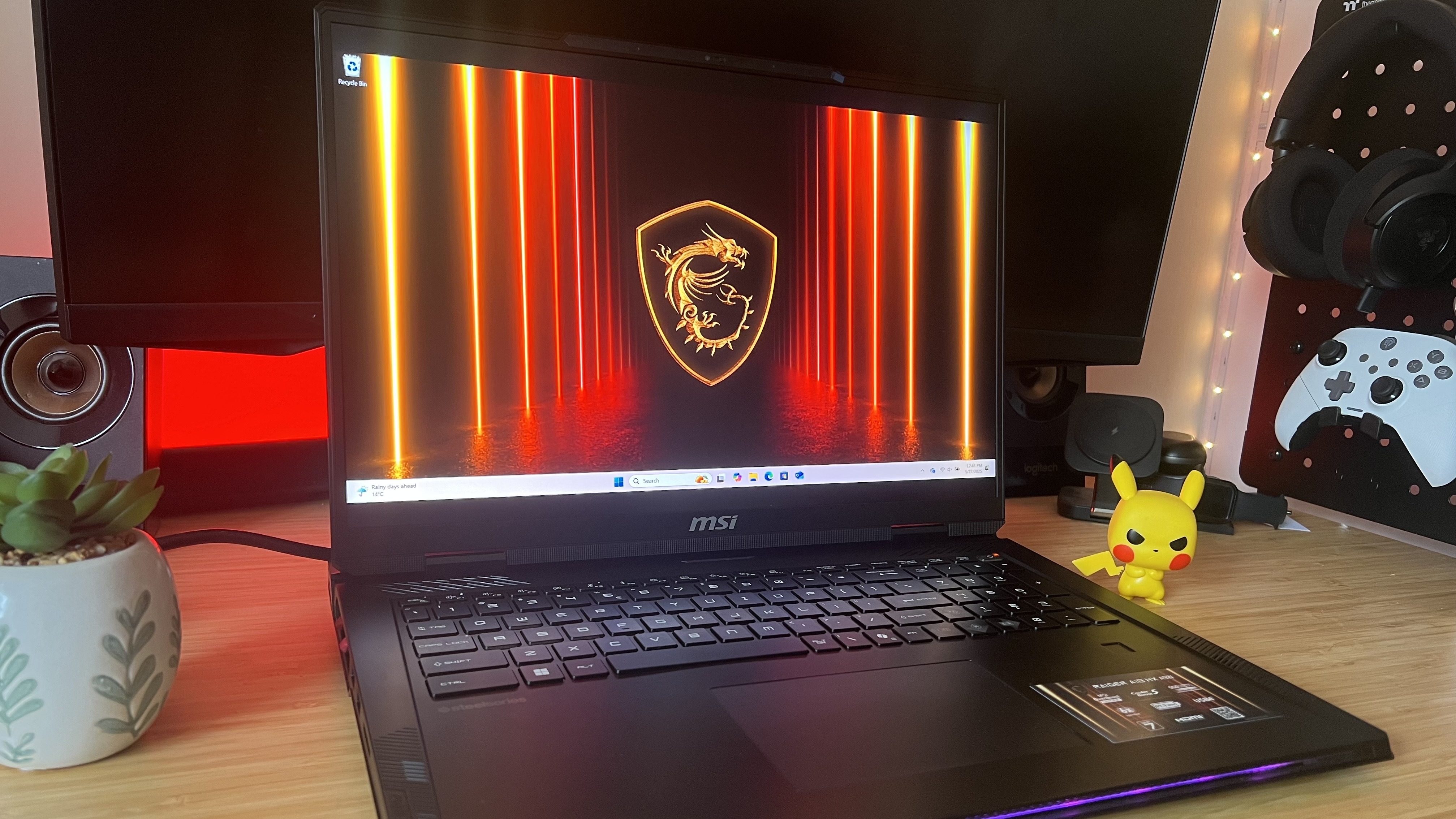GamesRadar+ Verdict
The MSI Raider A18 HX A9W is a real beast, pairing a blindingly fast processor with an equally speedy SSD, and using that RTX 5090 to its full potential to just edge ahead in the power rankings. Its 4K 120Hz display is a delight for single-player adventures, but its emphasis on immersion will keep more competitive players at bay, while its build quality is a little disappointing for the price.
Pros
- +
Incredible 4K display
- +
Blindingly fast processor
- +
Speedy Gen 5 SSD
- +
Upgraded to Thunderbolt 5
Cons
- -
Raider build at Titan prices
- -
Low quality keyboard and trackpad
- -
Others use a dual-mode screen
Why you can trust GamesRadar+
The MSI Raider A18 HX A9W is the most powerful rig I've tested so far, which means it's going to end up in my rankings of the best gaming laptops on the market. It's far from an easy recommendation, though.
This is a Raider through and through, with a plastic chassis that doesn't match up to its price tag in quality, though with the price tag of a Titan. The test unit I've received currently goes for $5,609.99 via MSI's own channels - $300 more than last year's aluminum monster. Still, with a 4K display that truly will knock your socks off - and a blindingly speedy AMD Ryzen 9 9955HX3D / RTX 5090 pairing - this is certainly a single-player's dream machine.
| Row 0 - Cell 0 | Tested | Also Available |
Price | $5,609.99 | $4,509.99 |
Display | 18-inch UHD+ Mini LED at 120Hz | - |
Processor | AMD Ryzen 9 9955HX3D | - |
GPU | Nvidia GeForce RTX 5090 | RTX 5080 |
RAM | 64GB | - |
Storage | 2TB SSD | - |
Ports | 3x USB 3.2 Gen 2, 2x Thunderbolt 5 (DisplayPort, Power Delivery), 1x SD card reader, 1x HDMI 2.1, 1x 3.5mm audio, Ethernet | Row 7 - Cell 2 |
Dimensions | 1.26 x 15.91 x 12.09 inches | Row 8 - Cell 2 |
Weight | 7.94lbs | Row 9 - Cell 2 |
Configurations
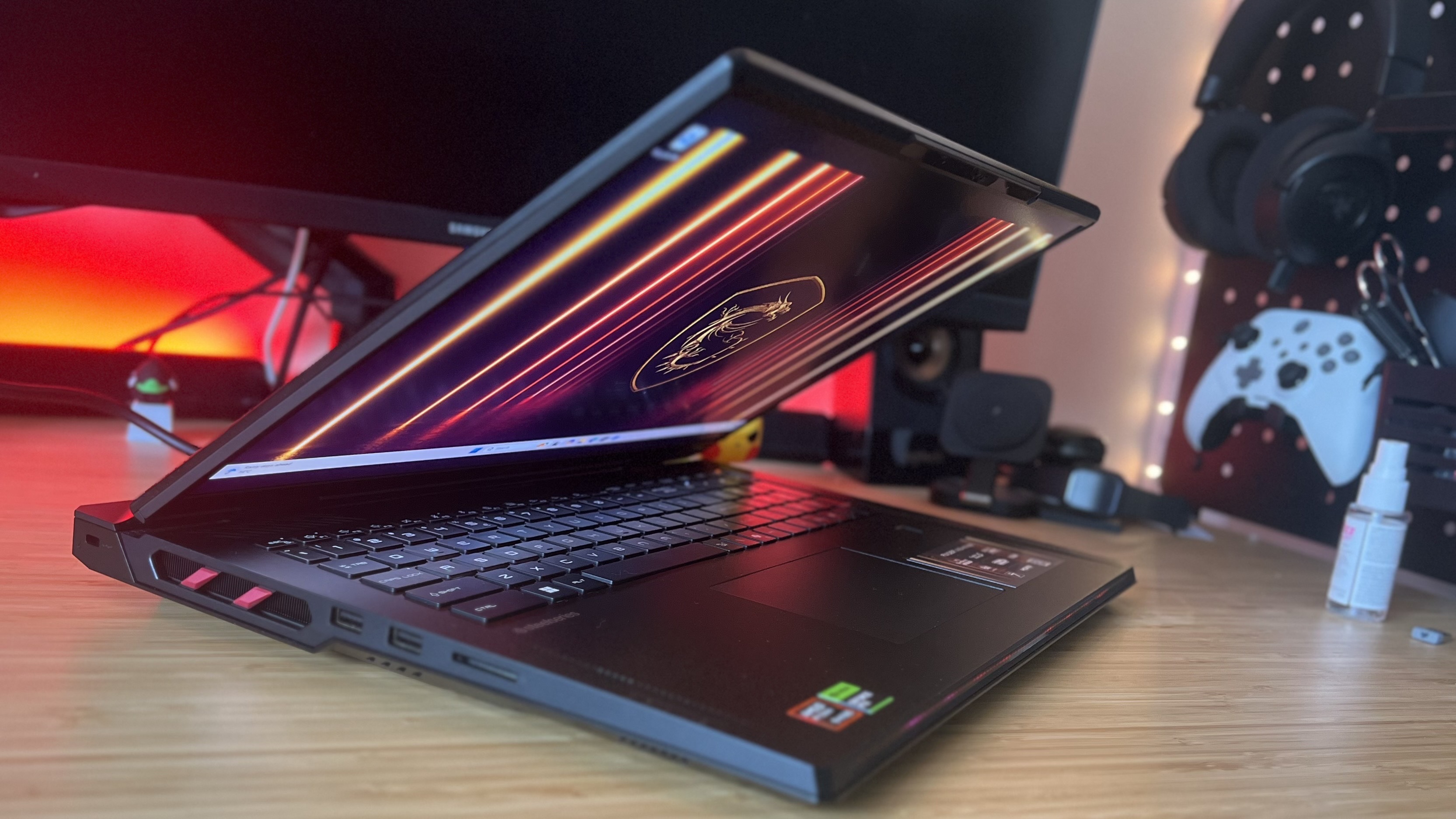
The MSI Raider A18 HX is the only mainstream gaming laptop model pairing the AMD Ryzen 9955HX3D processor with an RTX 5090 GPU. That's a potent combination, and considering I've found that AMD's processors are generally going a bit further than Intel's this generation, it could well be the gold standard for chunkier, performance-driven rigs.
That RTX 5090 is supported by the full 175W (and I've got the power brick to prove it), with 260W total power up for grabs across the GPU and CPU. That's the same as the 2025 Asus ROG Strix Scar 18 from a GPU perspective, though the MSI Raider can give the CPU 85W of dedicated power compared to 80W on Asus's model.
In short, there's a hell of a lot of power going into this machine.
Configurations are limited to that AMD processor, though there's a cheaper RTX 5080 version on the shelves as well. There's also an A2X model, which drops you down to an Intel Core Ultra 9 285HX GPU.
You're certainly paying for all that juice. Like all MSI Raider A18 HX models currently available, the configuration I've been testing comes stacked with 64GB DDR5 RAM and a 2TB PCIe Gen 5 SSD (yep, this is the first gaming laptop I've tested with new-generation storage), and costs $5,609.99 at checkout. That's pretty much as expensive as you can get in today's market and a considerable price increase from last year.
Weekly digests, tales from the communities you love, and more
The RTX 4090 / Intel Core i9-14900HX MSI Raider 18 HX I tested previously came in at $3,999.99 with the same RAM and storage amount, though an older Gen4 drive. For reference, the AMD Ryzen AI 9 HX 370 / Nvidia RTX 5080 Scar model I reviewed earlier this month sits at $3,169.99.
Design
Just like last year's model, the 2025 MSI Raider A18 HX is chunky. This is still a cumbersome 18-inch behemoth with no time for portability, it's designed to sit on your desk and stay there for most of its life.
This is the same 1.26-inch thickness as the Asus ROG Strix Scar 18, though it doesn't benefit from the same slanted front lip, making it appear stockier sitting on the desk in front of me.
The RGB lighting strip along the front has been slimmed down compared to the previous generation, but its placement above an extra ridge of plastic means that the light show doesn't shine onto the desk below in the same way. Asus's RGB extends all the way around the perimeter of the laptop, giving the equally large machine a lighter feel, as if it's floating slightly above the surface on which it stands.
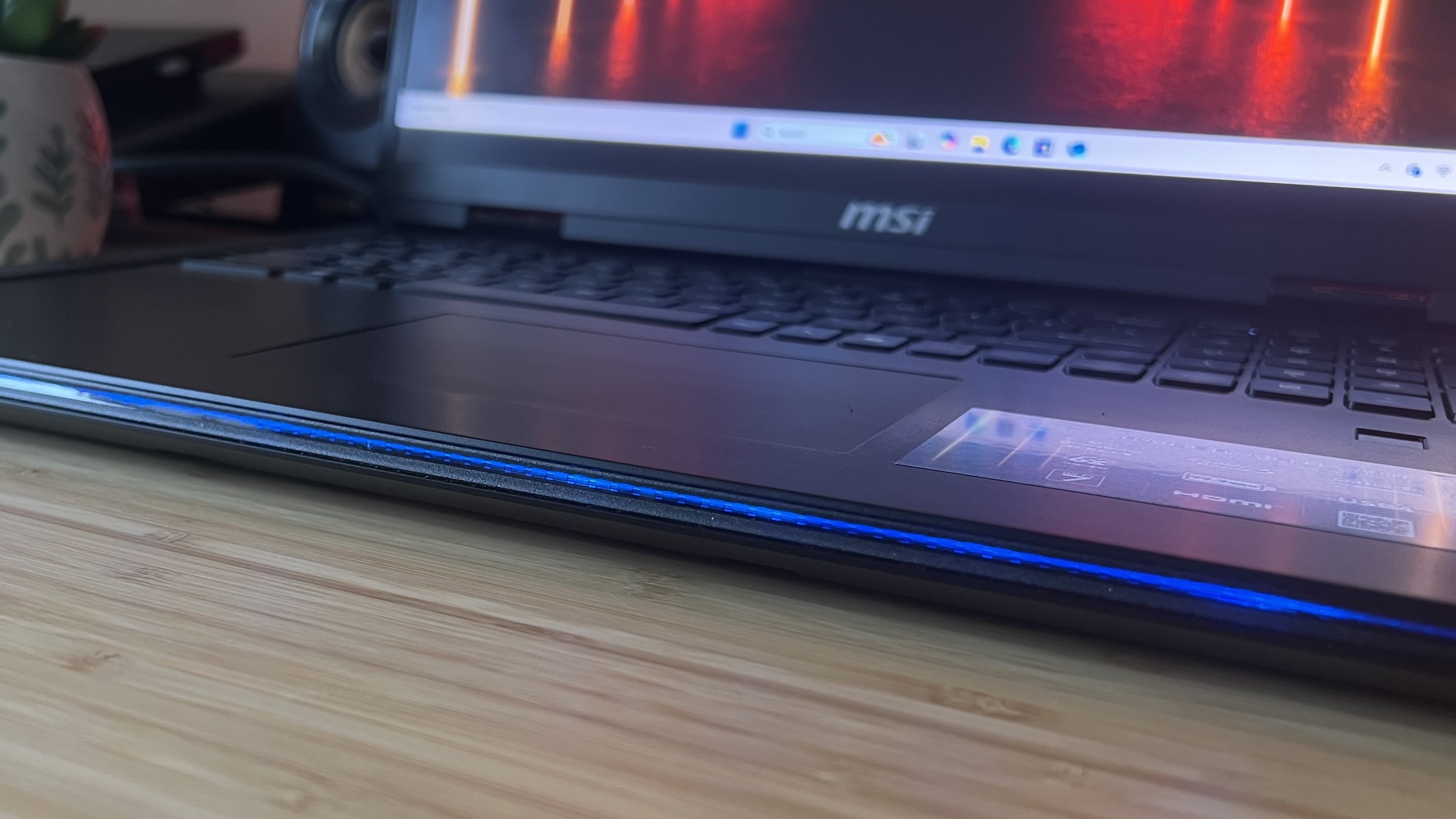
The main deck still features the angular cut-outs around the keyboard and trackpad area, nodding to the Raider's gamerfied design past but staying slightly more subtle than previous models. It's not the most business-forward design on the market - the Razer Blade 18 does a fantastic job of keeping its insides slick and suave. Instead, it's just toeing the line before becoming gaudy.
Like last year's model, there's still flex to the main chassis area, and considering 2025's release comes in at nearly $6,000, that's pretty disappointing. The whole corner of the lower deck bends significantly when manipulated or picked up and creaks slightly in the process. It's not enough to concern me in the short term, though it's not what I'd expect to see from a gaming laptop at this price point. After all, we're now paying MSI Titan 18 HX prices for a Raider, and that rig had a far sturdier build quality.
The underside also remains largely unchanged from the previous release, with additional rubber grips on each corner further elevating the chassis and providing extra space for airflow below. This is still a plastic construction (unlike the aluminum used in the Titan last year) all over, which is a little disappointing considering the final price.
There is, however, noticeably less screen wobble on the 2025 model compared to last year's. I found that the 2024 version would jiggle with heavier typing, whereas the hinge on the newer release feels a little sturdier.
Display
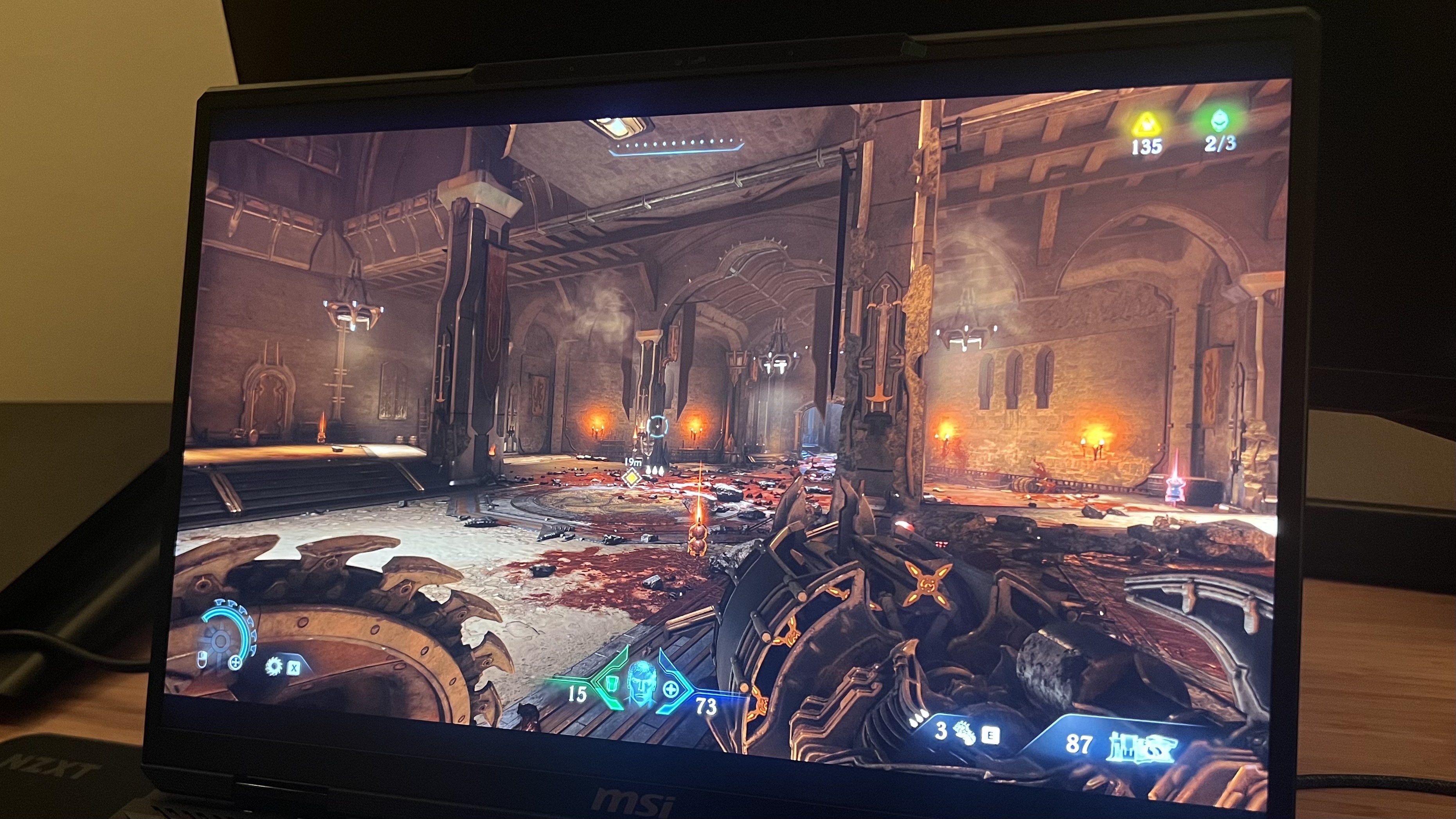
MSI's 4K Mini LED panel is here to stay for another year, offering gorgeous color contrast and a super detailed handling of both HDR and SDR content. The panel itself covers 100% of the DCI-P3 spectrum, offering 1,000 nits of brightness, alongside a 2,000,000:1 contrast ratio and local dimming features. That's a high-end Mini LED display.
Like last year, MSI has gone a different route compared to most of the competition, though. This is a 4K (well, UHD+ if you want to get technical about the aspect ratio) 120Hz panel, boosting the resolution but lowering the refresh rate compared to most QHD+, 240Hz devices (like the Scar 18). That makes sense if you're running all your games in full 4K resolution - you'll rarely need more than a 120Hz refresh rate to keep your games looking smooth.
However, things get a bit tricky when you take lower resolutions into account, alongside that premium price tag. Lowering game resolution to take advantage of higher refresh rates (and therefore more responsive inputs) is often imperative in competitive scenarios, but 4K panels that prioritize immersion often neglect this market.
Razer's gone all in on its own 2025 Blade 18, using a dual-mode display that can run at UHD+, 240Hz, or FHD+ 440Hz. A like-for-like configuration of that machine (albeit with an Intel Core Ultra 9 275HX processor) comes in at $5,199.99, just over $400 less than the MSI Raider A18 HX. It's a wonder, then, why MSI isn't going down this dual-mode route with its own high-end rig, it would have certainly gone a lot further to justifying such a lofty MSRP.
This screen isn't about pure speed, though; it's about immersion, and it nails the brief. 18-inch panels are already going to lock you into your game worlds much better than smaller 16-inch or 14-inch gaming laptops, but when colors are this vivid and details this sharp, single-player adventures pack a serious punch. If you're a solo adventurer, investing more in a high-powered processor than a dual-mode screen is going to be the way to go.
Ports
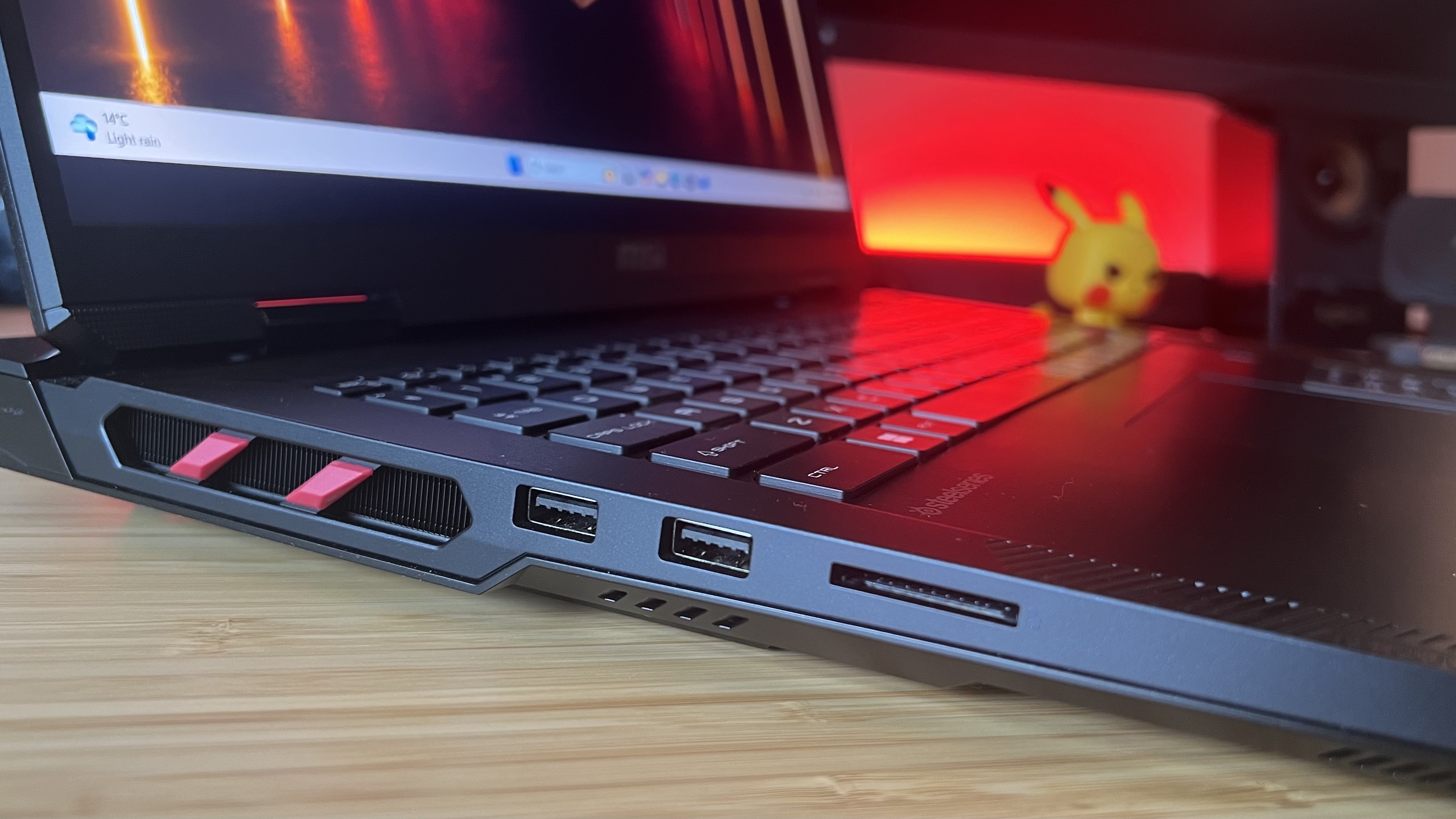
The biggest upgrade to this year's port selection is MSI's move to Thunderbolt 5. While last year's model offered two Thunderbolt 4 connections, we've got the new generation ports whirring away under the hood of 2025's iteration.
That means faster transfer speeds with an increased 80 Gbps bandwidth (compared to 40 Gbps) and an increased power delivery of up to 240W, more than double that of the 100W Thunderbolt 4. It also means you'll be able to connect a higher refresh-rate monitor (up to 540Hz).
These USB-A and Thunderbolt connections are split across each side of the laptop, with two USB-A 3.2 Gen 2s on the left, and another on the right alongside both Thunderbolt options. The right side also houses the system's 3.5mm audio jack, while the left benefits from a full-sized SD card reader.
All your permanent connections are located around the rear, which makes for a far tidier setup overall. It means that the massive power connector stays out of the way, alongside the HDMI 2.1 and Ethernet ports. It's a shame there isn't a Thunderbolt 5 to the rear - this would have been handy for dock users, and would keep the sides free for your mouse hand.
As it stands, the MSI Raider A18 HX still suffers from a little cable sprawl, but if you're using wireless accessories, the 2.4GHz receivers shouldn't get in the way too much, and you're larger connections are all tucked away out of sight.
Keyboard and trackpad
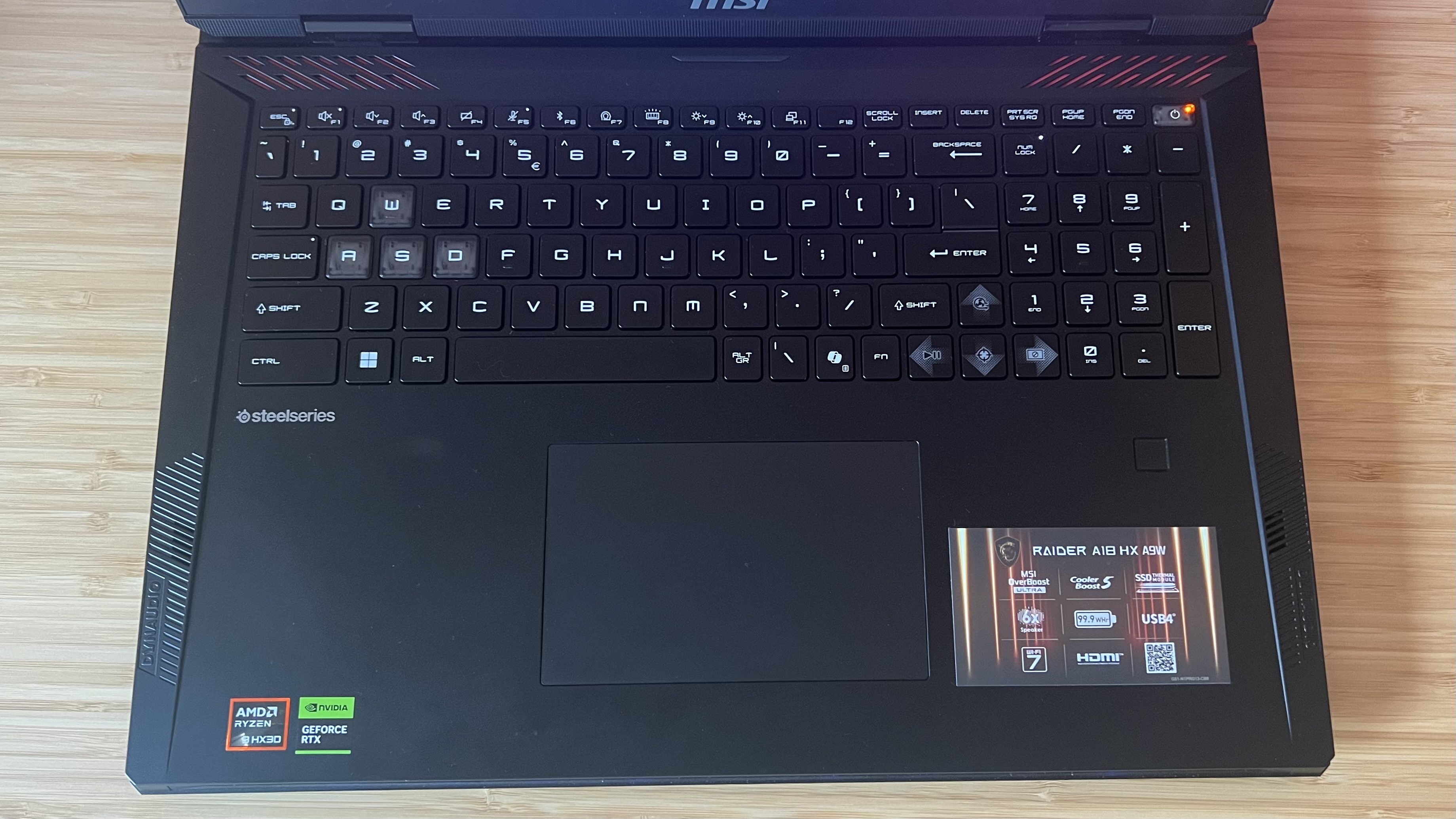
SteelSeries has provided the keyboard for the MSI Raider A18 HX once again this year, but this isn't the snappy mechanical deck you might expect. Under the fingertips, this deck borders on mushy with a particularly soft landing position and very little travel. It's not a pleasant experience.
I was taken aback by the keyboard. This is a nearly $6,000 gaming laptop, and there's more flex in the main deck than the budget Asus TUF A15. It's a full-sized design, with a good-sized number pad, arrow keys, and function row, but I still felt cramped. Doom: The Dark Ages requires fast muscle memory between the E and R keys, and I never felt like I had enough space to accurately hit either without mashing both.
There's a good amount of spacing, so it's not like the keys are necessarily too close together, but I expect the softer landing and low travel make them particularly easy to mis-hit when working through faster moments.
The trackpad is incredibly small for a gaming laptop of this size, and I'm constantly hitting the lower lip when zipping through Chrome tabs and spreadsheets. There's a decent snap to a harder press here, if a little heavier than I've used in the past, and my finger glides smoothly across the surface.
Performance
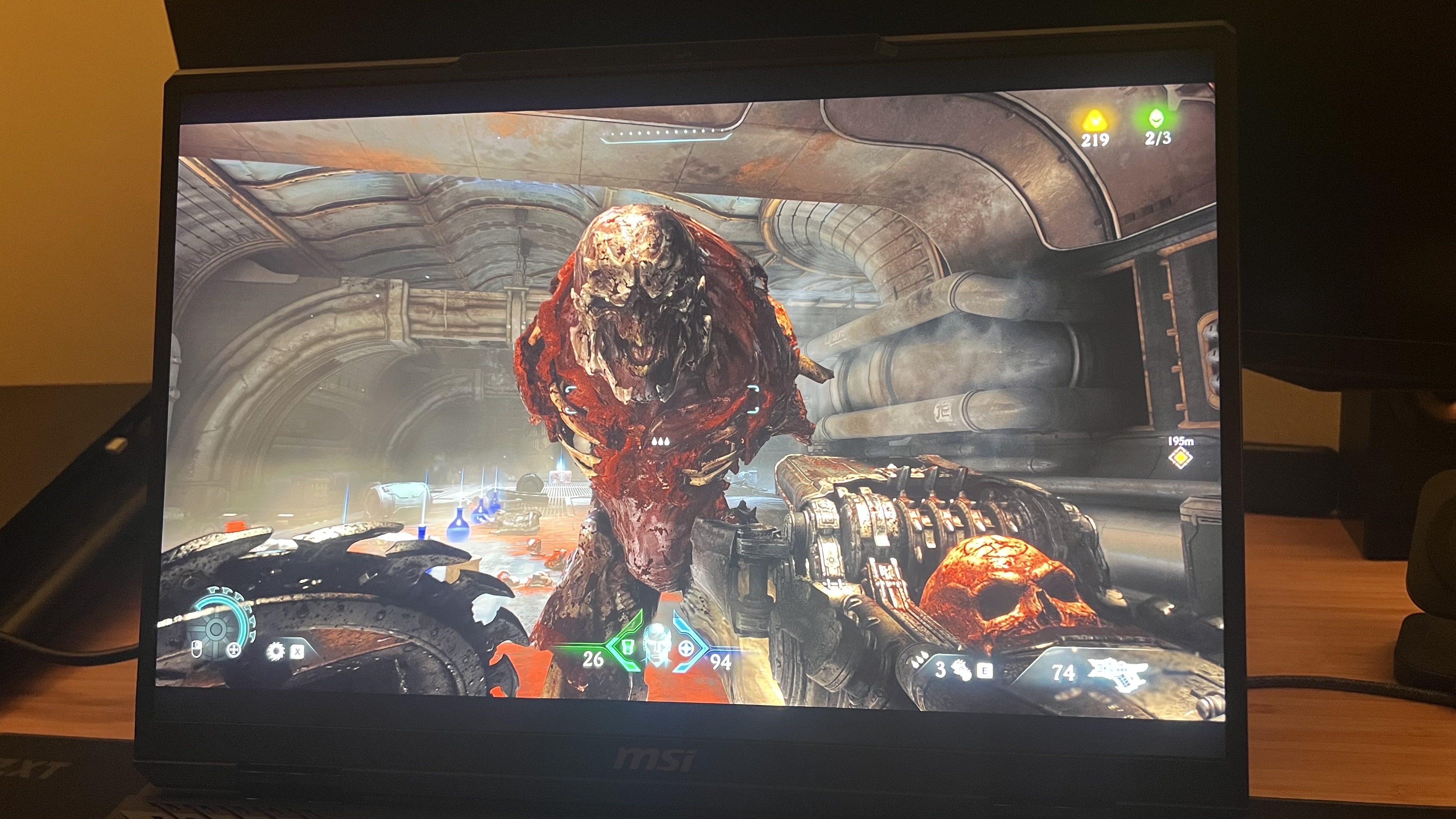
I keep saying this, and then another gaming laptop comes along and changes things, but as of this review, the MSI Raider A18 HX A9W is the most powerful gaming laptop I've tested. That means I now need to go back to my Asus ROG Strix Scar 18 review and update a few things.
The Raider outperforms the Scar 18 in RTX 5090 gaming across the majority of games (though there are some drops) in both FHD and QHD resolutions, and steps things up when compared against last year's Titan and Raider models as well. Would I have liked to see a better gen-on-gen performance increase from the RTX 4090? Absolutely, but it's clear Nvidia isn't giving us that this generation.
The 2025 iteration is on top compared to the RTX 4090 MSI Raider 18 HX, but the size of the leap is much, much smaller than I saw in the move from the RTX 30-Series. All of the benchmarks below were recorded with dedicated GPU power in the device's top performance setting without frame generation. It should also be noted that Shadow of the Tomb Raider benchmarks are slightly anomalous. I've run and re-run these tests and confirmed that no extra features are switched on - it seems this rig is just really good at running Lara Croft at FHD.
Increases in natively rendered framerates between generations remain only slightly raised across the majority of FHD and QHD+ benchmark runs. Interestingly, the 2025 MSI Raider A18 actually performs significantly worse in 4K Shadow of the Tomb Raider tests, even if it inches ahead with 86fps / 63fps in Total War: Three Kingdoms. This is the first 4K MSI gaming laptop to run into 60fps+ territory in Ultra settings on this title, but we're only just over that threshold.
These are still excellent results, proving the MSI Raider A18 HX A9W can handle pretty much anything you want to throw at it. I'm going to keep digging on those strange Tomb Raider numbers, though, and will update this review if I find any evidence of a missfire.
Nvidia's DLSS tricks are less of a concern for an 18-inch powerhouse. In a slimline gaming laptop like the 2025 Asus ROG Zephyrus G14 or 2025 Razer Blade 16, this focus on frame generation features makes sense. There's only so much power you can throw into a gaming laptop and still fit it (and its charging brick) into a backpack. Looking at the size of the MSI Raider A18 HX A9W's power supply and the thickness of this chassis, we don't need so many AI tricks in here.
Still, without frame generation switched on, I was only able to scrape around 59fps out of Cyberpunk 2077 in 4K RT Ultra. At full 4x MFG whack, things were hovering around a far more comfortable 86, with minimal intrusion to the play space itself. DLSS isn't the power feature Nvidia thinks it is in this chassis, but it's certainly a neat trick if you want to run demanding titles at full UHD whack.
Synthetic benchmarks show a 34% improvement between the RTX 4090 2024 model and this year's RTX 5090 iteration in easier Fire Strike tests, with that rate falling to 4.7% in Time Spy. More impressively, though, the harshest test of the suite, Steel Nomad, yielded a 22.23% performance increase between generations.
That's not particularly reflected in-game, but it does provide a little extra hope for future-proofing against more demanding titles to come.
Onto the CPU, and what a CPU this is. The AMD Ryzen 9 9955HX3D doesn't make its way into many gaming laptops, but it certainly tops the charts when it can. With a 9,077 PC Mark 10 score, it flies well over the head of the Intel Core i9-14900HX I tested in the Lenovo Legion Pro 7i Gen 9, as well as the newer Intel Core Ultra 9 275HX inside this year's Asus ROG Strix Scar 18.
Not only do we have a turbo-charged processor in here, but that Gen5 SSD absolutely sings as well. This is a big step up from the previous generation drives found in the rest of the market. MSI quotes up to 12,000MB/s read speeds, but I repeatedly benched just over 14,300MB/s in Crystal Disk Mark. Granted, that's a synthetic run with a relatively small amount of that 2TB drive taken up, but it's still well above the usual rates.
Battery
Battery life is certainly not usually a strong suit of larger 18-inch gaming laptops. The size of the power brick can certainly attest to that. However, in the system's most power-efficient settings, running a few Chrome tabs for productivity, the MSI Raider A18 HX managed to run for well over three hours in my tests (three hours and 20 minutes to be precise). You'll lose that 20 minutes if you opt for Balanced mode in the same use case, with my test running short at just a hair over three hours.
I just about managed to scrape over the hour mark while gaming. This rig isn't built for on-the-go sessions, so you won't get the same kind of juice as the Asus ROG Flow Z13, for example. My Doom: The Dark Ages visual settings did have to slide down a little to accommodate, and there was a little stuttering - though not nearly as much as a weaker gaming laptop would have produced just a couple of years ago.
Should you buy the MSI Raider A18 HX (2025)
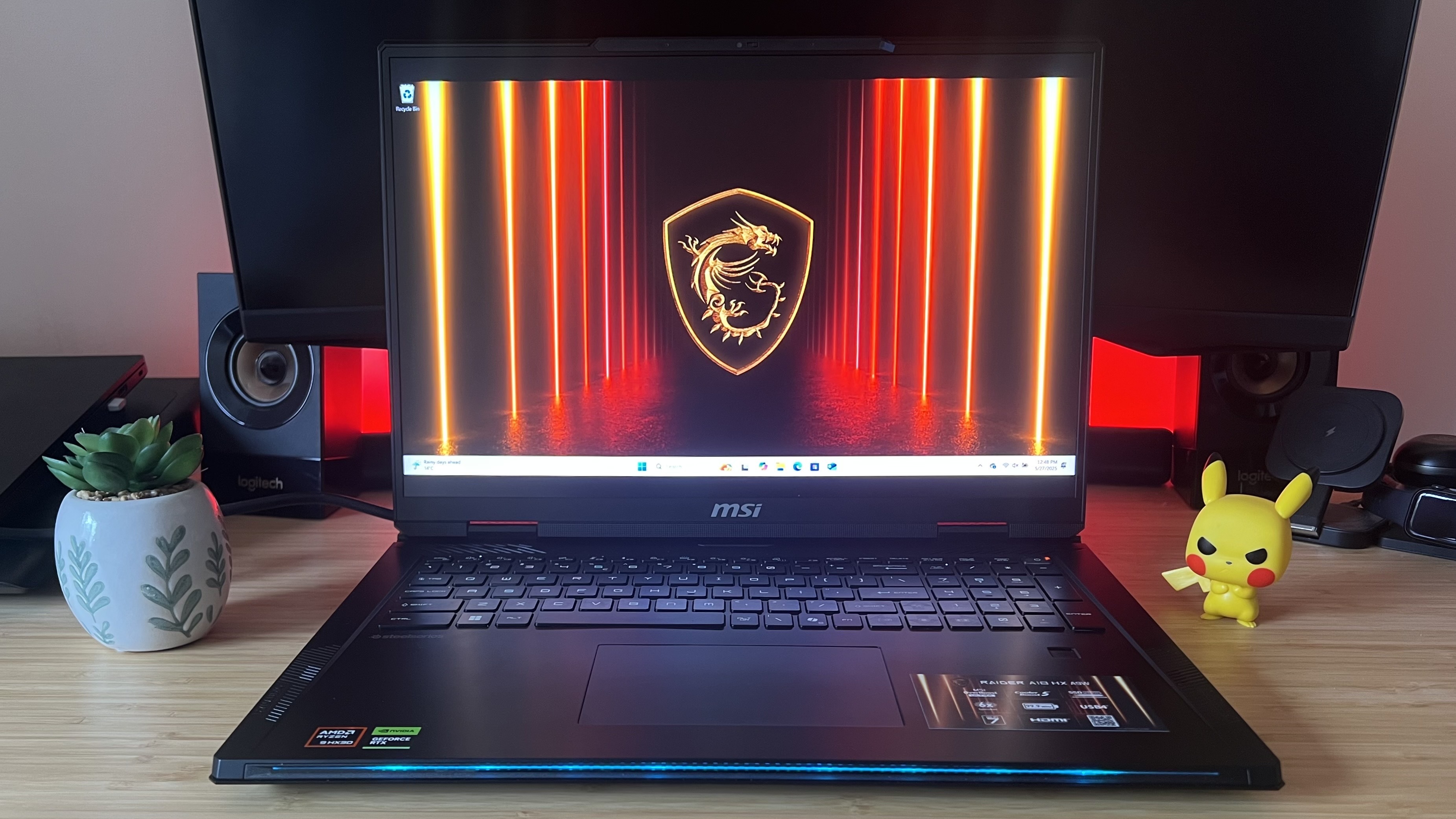
The 2025 MSI Raider A18 HX is an extremely impressive gaming laptop on the whole, but I wouldn't recommend it easily. It's certainly among the top rigs I've tested so far, but its Titan-esque price point despite its lower build quality is a major sticking point. The RTX 5090 under the hood does take us further towards 4K gaming at max settings, but not enough to warrant the additional cost if your sole intention is to chase the highest framerates possible at UHD levels. As long as there are cheaper RTX 4090 MSI Titan machines on the shelves, this is a tough sell indeed.
That's not to take away from what the MSI Raider A18 HX does right. I'm going to have a hard time saying goodbye to ripping and tearing through Doom on this fantastic panel, and the processor is an absolute blinder. Those benefits aren't quite potent enough to offset the increased cost we're seeing from this generation of machines, though they're certainly worthy of an investor's (and future-proofer's) attention.
How I tested the MSI Raider A18 HX (2025)
I used the MSI Raider A18 HX as my sole laptop for both work and play over the course of two weeks. I started off by running my usual suite of in-game benchmarks, testing Shadow of the Tomb Raider, Total War: Three Kingdoms, Horizon Zero Dawn: Remastered, Cyberpunk 2077, and Black Myth: Wukong without DLSS frame generation. These tests were run across high and highest settings in 1080p, 1600p, and 4K resolution, repeated three times each with the final score taken as an average. Cyberpunk 2077 was tested with Super Resolution set to Balanced and Black Myth: Wukong's Super Resolution was at 60.
I then further tested the RTX 5090's Multi-Frame Generation features in Cyberpunk 2077, running the game with full ray-tracing in 4K with Super Resolution set to Quality.
Synthetic benchmarks were taken from 3D Mark's Time Spy, Fire Strike, and Steel Nomad runs, while the CPU was directly tested across PC Mark 10. I then tested the sequential read and write speed of the SSD using Crystal Disk Mark. Again, each test was completed three times, with the final score reflecting an average of all data.
I tested the battery in everyday conditions, measuring over the course of multiple work sessions and gaming sessions across all available power modes, though with display brightness always set at 50%.
For more information on how we test gaming laptops, check out the full GamesRadar+ Hardware Policy.
I'm also hunting down all the best Alienware laptops and the best Razer laptops on the market, or take a look at the best Asus gaming laptops available now.

Managing Editor of Hardware at GamesRadar+, I originally landed in hardware at our sister site TechRadar before moving over to GamesRadar. In between, I've written for Tom’s Guide, Wireframe, The Indie Game Website and That Video Game Blog, covering everything from the PS5 launch to the Apple Pencil. Now, i'm focused on Nintendo Switch, gaming laptops (and the keyboards, headsets and mice that come with them), PS5, and trying to find the perfect projector.
You must confirm your public display name before commenting
Please logout and then login again, you will then be prompted to enter your display name.
